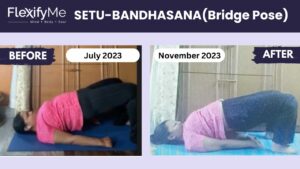We’ve been explaining how to do various Yoga Poses on our blog, but did not point out specific points on how each pose could heal illnesses such as back pain and so forth. In this episode, we will list down the 3 best yoga poses for back pain that you can practice on your own and experience the magic healing. These practices have been approved by our professional and trained Yoga Coaches.
1. Balasana (aka Child’s Pose)
This is usually referred to as one of the easiest Yoga Poses in Yoga besides Savasana (Corpse Pose). It’s a gentle pose that can help you release pain in your back by stretching your lower back and ease lower back pain.

How to do a balasana (Child Pose)
Starting on your hands and knees, sit back and bring your hips toward your heels.
Then, stretch your arms out in front of you and place your palms on the floor.
Relax your forehead to the ground and pause for some big, deep breaths. If you cannot bend or reach all the way down to complete this pose as pictured, don’t worry. Do not push your body any further than it can naturally stretch.
2. Chakravakasana (aka Cat Cow Pose)
Best known for massaging your spine, the cat cow pose (aka Chakravakasana) helps to target the lower, middle and upper back pain.
How to do a Chakravakasana;
Start on your hands and knees with your hands shoulder-distance apart and your knees hip-distance apart.
Slowly inhale and look upwards towards the sky, slightly arching your back as you do so.

Then, as you slowly exhale, look back down towards the floor while drawing your belly button towards your spine, arching your back.

Repeat this process as many times as you like, continuing to match the movements to your inhales and exhales
3. Bhujangasana (aka Cobra Pose)
Another yoga pose to help stretch the back and ease back pain, cobra pose (aka Bhujangasana) is also very simple.

Start by lying on the floor, on your front. Stretch your legs back and keep the tops of your feet facing the floor. Press the tops of your feet, thighs and pelvic bone into the floor. Place your hands on the floor under your shoulders, hugging your elbows into your sides.
Inhale and straighten your arms to lift your chest off the floor, keeping your pelvic bone in contact with the floor. Hold for 15-30 seconds, taking some deep breaths. Release back to the floor as you exhale.
Additionally, you can watch one of our reels on Instagram listing some Asanas you can practice to reduce back pain.
With assisted help by a professional FlexifyMe Coach, you could start experiencing changes to your back pain in a few weeks. Our coaches are professionally trained and they’ll usually recommend you to see a doctor if the condition seems to be beyond Yoga or other reasons. You can read more about how some of our clients have transformed after opting Online Yoga with us.
Frequently Asked Questions
What benefits does meditation offer for managing stress and improving sleep?
FlexifyMe's meditation sessions are crafted to aid in stress relief and enhance sleep quality, forming an integral part of our comprehensive wellness programs.
Can FlexifyMe help with weight loss through yoga?
Yes, our programs include yoga for weight loss, combining physical postures, breathing techniques, and meditation to help you achieve your fitness goals in a holistic manner.
Are FlexifyMe's yoga and meditation programs suitable for beginners?
Absolutely, we offer yoga for beginners and meditation guidance that's customized to your pace and starting level, ensuring a supportive and effective introduction to wellness.
How do FlexifyMe's corporate wellness programs benefit employees?
Our corporate wellness programs are designed to promote health and fitness in the workplace, offering online yoga classes and meditation sessions that fit into busy schedules and support overall employee well-being.
What kind of personalized yoga instruction does FlexifyMe provide?
Our personalized yoga instruction is tailored to individual health and wellness goals, ensuring you receive one-on-one guidance that caters to your specific needs, whether it's for fitness, stress relief, or prenatal care.
How does FlexifyMe accommodate prenatal yoga needs?
We offer specialized prenatal yoga sessions that focus on gentle poses and breathing techniques to support health and wellness throughout pregnancy.
What differentiates FlexifyMe's approach to wellness and fitness?
FlexifyMe's holistic approach combines yoga, meditation, and nutrition advice, offering a rounded path to health and fitness that adapts to your lifestyle and personal goals.
Can FlexifyMe's online yoga classes be scheduled around my busy lifestyle?
Yes, our online yoga classes offer flexible scheduling options to seamlessly integrate into your lifestyle, ensuring you can maintain your fitness and wellness routine without hassle.
Does FlexifyMe offer any specialized programs for stress relief?
Our wellness programs include specialized yoga and meditation sessions focused on stress relief, designed to help you manage anxiety and improve your overall health.


